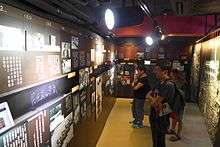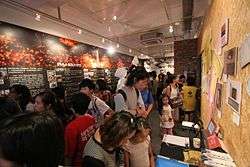June 4th Museum


The "June 4th Museum" (Chinese: 六四紀念館) is the world's first memorial museum for the Tiananmen Square protests of 1989 that happened in Beijing, China. The permanent museum is located in Tsim Sha Tsui Hong Kong housed in a 1,375 sq ft. space, and is organized by the Hong Kong Alliance in Support of Patriotic Democratic Movements in China. It opened on 26 April 2014, shortly before the 25th anniversary of the incident.
However the museum received many complaints from the building owners, such as breached the mutual covenant of the building. The museum closed on 11 July 2016. It is not evident when it will open again.[1]
Purpose
The purpose of the museum is to give residents from mainland China an opportunity to learn more about the Tiananmen Square protests of 1989, the history of which is censored in China outside Hong Kong. Local residents can also explore the history of democracy and freedom in China.[2]
Museum

Temporary museums
Before the permanent museum opened in 2014, there were two temporary museums open for short periods—the first in 2012 and the second in 2013. The temporary museums were named June 4 Memorial Museum (六四紀念館), hosted by the Hong Kong Alliance in Support of Patriotic Democratic Movements in China. The first temporary museum was located at 269 Yu Chau Street, Sham Shui Po, Hong Kong, and was open between 29 April 2012 and 10 June 2012. The second was located at I-Café in the City University of Hong Kong from 12 April 2013 through 15 July 2013.[3]
Permanent museum
The permanent site is on the fifth floor of the Foo Hoo Centre at 3 Austin Avenue in Tsim Sha Tsui in Hong Kong. The owner of the site is the non-government organization Hong Kong Alliance in Support of Patriotic Democratic Movements in China, costing 9.76 million Hong Kong dollars. The museum is named the June 4th Museum (Chinese: 六四紀念館; the Chinese name is the same as was used for the temporary museums).[4][5] It opened to the public on 26 April 2014. The museum occupies 800 square feet, and Its budget is approximately HK$800,000 per year.[6]
A complaint was filed against the museum shortly before it opened by the corporation that owns the building housing it, claiming that the museum violates the building covenants, as it is not using the space as an office and will bring in an excessive number of visitors.[7] A lawsuit on this matter is being funded not by the owning corporation but "privately" by its chairman.[6]
Exhibits
The museum contains artifacts, photographs and information which are related to the incident. The exhibits include the casings from bullets shot by the People's Liberation Army in Tiananmen Square and a raincoat which was worn by a resident of Hong Kong who went to Beijing to support the Democracy Movement. The museum also contains T-shirts signed by the student leaders including Wang Dan and Chai Ling. Moreover, the museum provides a multi-media area, heritage area, history area and a library.[2] A Goddess of Democracy statue, which at 6 feet 4 inches (1.93 m) in height symbolizes June 4, will be displayed in the permanent museum.[8]
 Mini Theatre
Mini Theatre Central Exhibition Area
Central Exhibition Area Books Corner
Books Corner Photo taking area
Photo taking area Narrow Road
Narrow Road
References
- ↑ "Hong Kong museum commemorating Tiananmen massacre to close". CNN. 11 July 2016.
- 1 2 年終回顧:香港六四紀念館 李旺陽死亡真相 (in Chinese). Voice of America. 11 December 2012.
- ↑ 六四紀念館城大重開 (in Chinese). Apple Daily. 12 April 2013.
- ↑ 支聯會斥976萬 購六四紀念館永久地址 (in Chinese). The House News. 18 December 2013.
- ↑ 「六四紀念館」延至4月26日開幕 (in Chinese). Apple Daily. 15 April 2014.
- 1 2 Chong, Tanna (27 April 2014). "June 4 museum opens amid protests and threat of lawsuit". South China Morning Post. Retrieved 4 June 2014.
- ↑ Chan, Yanmic (11 April 2014). "June 4th Museum runs into Trouble". ISSUU HK Magazine. Retrieved 15 April 2014.
- ↑ 藝術系生製民主女神像置紀念館 (in Chinese). now.com. 18 April 2013.
External links
| Wikimedia Commons has media related to June 4th Museum. |
- Official website of "June 4th Museum"
- Official website of Hong Kong Alliance In Support Of Patriotic Democratic Movements Of China